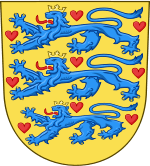Abel, King of Denmark
Abel of Denmark (1218 – 29 June 1252) was Duke of Schleswig from 1232 to 1252 and King of Denmark from 1250 until his death in 1252. He was the son of Valdemar II by his second wife, Berengária of Portugal, and brother to Eric IV and Christopher I.[1]
As Duke of Schleswig, Abel came into conflict with his brother, King Eric IV, whose murder in 1250 he was suspected of orchestrating. Upon taking an oath to clear himself of the allegations, he was elected king. After a short reign, he was killed during a military expedition in Frisia.
Abel's reign was the shortest of any Danish monarch since the 9th century. He founded a line of Dukes of Schleswig - the "Abel family" - which ruled the Duchy of Schleswig until 1375.
Early life
At the election in 1232 of his elder brother Eric as their father King Valdemar II's coruler and heir, Abel was chosen to succeed Eric in his position as Duke of Schleswig.
In 1237 he married Matilda of Holstein, a daughter of Adolf IV, Count of Holstein. As Count Adolf withdrew to a Franciscan friary the same year, Abel spent several years acting as regent for his under age brothers-in-law, John and Gerhard.
Duke of Schleswig
At the death of Valdemar II in 1241, Duke Abel's brother Eric acceded to the throne of Denmark as Eric IV. The following years Duke Abel fought against his brother, trying to gain independence for the Duchy of Schleswig. He raided north as far as Randers, ravaging Eric's supporters and then moved into Funen. Eric struck back a year later surprising Abel's garrison at Schleswig, forcing Abel's young daughter Sophie to flee "without so much as a pair of shoes for her feet."
The fighting continued until Abel's sister Sophie of Brandenburg brokered a truce between Duke Abel and King Eric that held until 1250 when Eric was murdered while a guest at Duke Abel's residence at Schleswig.
King
Eric IV was slain by Abel's chamberlain, Lave Gudmundsen and others; the king's headless body dumped into the Schlei.
Even though Abel and twenty-four noblemen swore an official oath ("dual dozen's oath", in Danish "dobbelt tolvter-ed") that the Duke had no part in the killing, it was widely believed that King Eric was murdered at his brother's bidding. "Abel by name, Cain by his deeds" (Danish, "Abel af navn, Kain af gavn"), or so people said.
After clearing himself of the allegations taking the oath, Abel was proclaimed King of Denmark at the Viborg Assembly (Danish: landsting) on 1 November 1250.
Death
Abel only ruled for a year and a half. King Abel received word that the peasants in Frisia, led by Sicko Sjaerdema, refused to pay the tax levy. Abel raised an army to punish them. At the age of 33, he was killed by a wheelwright named Henner on Husum Bridge near Eiderstedt on 29 June 1252.
At the time, Abel's half-grown son Valdemar was held for ransom by the Archbishop of Cologne, and so Abel's youngest brother Christopher I, was crowned King on Christmas Day 1252 in Lund Cathedral.
After her husband's death, Queen Matilda entered a convent but later left it again. In 1261 she married Birger Jarl of Sweden.
Legacy
Most people at the time viewed Abel's sudden death as God's judgment on him for the murder of his brother. As Abel's body lay in Schleswig Cathedral, the monks heard strange sounds in the church at night. They said they were too afraid to go into the church after that. They believed that Abel's unholy ghost walked abroad at night. Consequently, the kings body was taken outside the church and stuffed into a soggy grave near Gottorp Castle outside Schleswig. Someone rammed a wooden stake through Abel's chest to make sure he remained in his grave. It was said long after that the king's ghost found no peace and from time to time there were reports of "Abel's wild hunt" where a black faced man on a white horse and glowing hounds hunted across the moors and forest of Schleswig.[2]
Abel's descendants — the "Abel Family" — ruled South Jutland until 1375, often in co-operation with their relatives in Holstein, and they created a permanent problem for the Danish government. Their rule meant the eventual separation of Frisia, Holstein, and most of Schleswig from the rest of Denmark. His great-grandson succeeded briefly as Valdemar III before being deposed, but Abel's descendants would return to the throne with the descendants of his great-granddaughter Helvig of Schleswig, who married Valdemar IV. And even though the line of Helvig died out with Christopher III, his successor Christian I was a descendant of Abel's through his daughter Sophie, so with the exception of Christopher I through Valdemar IV, all subsequent Danish monarchs have been Abel's cognatic descendant.
Marriage and issue
With his wife, Mechtild of Holstein, whom he married on 25 April 1237;
- Valdemar III (1238–1257); Duke of Schleswig 1254–1257
- Sophie (born 1240, d. aft. 1284), married Bernhard I, Prince of Anhalt-Bernburg. Their descendant was Christian I of Denmark.
- Eric I (c. 1241 – 27 May 1272); Duke of Schleswig 1260–1272
- Abel (1252–1279)
Ancestry
| Ancestors of Abel, King of Denmark | ||||||||||||||||||||||||||||||||||||||||||||||||||||||||||||||||||||||||||||||||||||||||||||||||||||||||||||||||||||||||||||||||||||||||||||||||||||||||||||||||||||||||||||||||||||||||||||||||||||||||||||||||||||||||||||||||||||||||||||||||||||||||||||||||||||||||||||||||||||||||||||||||||||||||||||||||||||||||||||||||||||||||||||||||||||||||||||||||||||||||||||||||||||||||||||||||||||||||||||||||||||||||||||||||||||||||||||||||||||||||||||||||||||||||||||||||||||||||||||||||||||||||||||||||||||||||||||||||||
|---|---|---|---|---|---|---|---|---|---|---|---|---|---|---|---|---|---|---|---|---|---|---|---|---|---|---|---|---|---|---|---|---|---|---|---|---|---|---|---|---|---|---|---|---|---|---|---|---|---|---|---|---|---|---|---|---|---|---|---|---|---|---|---|---|---|---|---|---|---|---|---|---|---|---|---|---|---|---|---|---|---|---|---|---|---|---|---|---|---|---|---|---|---|---|---|---|---|---|---|---|---|---|---|---|---|---|---|---|---|---|---|---|---|---|---|---|---|---|---|---|---|---|---|---|---|---|---|---|---|---|---|---|---|---|---|---|---|---|---|---|---|---|---|---|---|---|---|---|---|---|---|---|---|---|---|---|---|---|---|---|---|---|---|---|---|---|---|---|---|---|---|---|---|---|---|---|---|---|---|---|---|---|---|---|---|---|---|---|---|---|---|---|---|---|---|---|---|---|---|---|---|---|---|---|---|---|---|---|---|---|---|---|---|---|---|---|---|---|---|---|---|---|---|---|---|---|---|---|---|---|---|---|---|---|---|---|---|---|---|---|---|---|---|---|---|---|---|---|---|---|---|---|---|---|---|---|---|---|---|---|---|---|---|---|---|---|---|---|---|---|---|---|---|---|---|---|---|---|---|---|---|---|---|---|---|---|---|---|---|---|---|---|---|---|---|---|---|---|---|---|---|---|---|---|---|---|---|---|---|---|---|---|---|---|---|---|---|---|---|---|---|---|---|---|---|---|---|---|---|---|---|---|---|---|---|---|---|---|---|---|---|---|---|---|---|---|---|---|---|---|---|---|---|---|---|---|---|---|---|---|---|---|---|---|---|---|---|---|---|---|---|---|---|---|---|---|---|---|---|---|---|---|---|---|---|---|---|---|---|---|---|---|---|---|---|---|---|---|---|---|---|---|---|---|---|---|---|---|---|---|---|---|---|---|---|---|---|---|---|---|---|---|---|---|---|---|---|---|---|---|---|---|---|---|---|---|---|---|---|---|---|---|---|---|---|---|---|---|---|---|---|---|---|---|---|---|---|---|---|---|---|---|---|---|---|---|---|---|---|---|---|---|---|---|---|---|---|---|---|---|---|---|---|---|---|---|---|---|---|---|---|---|---|---|---|---|---|---|---|---|---|---|---|---|---|---|---|---|---|---|---|---|---|---|
| ||||||||||||||||||||||||||||||||||||||||||||||||||||||||||||||||||||||||||||||||||||||||||||||||||||||||||||||||||||||||||||||||||||||||||||||||||||||||||||||||||||||||||||||||||||||||||||||||||||||||||||||||||||||||||||||||||||||||||||||||||||||||||||||||||||||||||||||||||||||||||||||||||||||||||||||||||||||||||||||||||||||||||||||||||||||||||||||||||||||||||||||||||||||||||||||||||||||||||||||||||||||||||||||||||||||||||||||||||||||||||||||||||||||||||||||||||||||||||||||||||||||||||||||||||||||||||||||||||
References
- ↑ Hartley, Mick. The Duke of Schleswig-Holstein-Sonderburg-Glücksburg. 27 Sep. 2007. 14 Feb. 2008 http://mickhartley.typepad.com/blog/2007/09/the-duke-of-sch.html.
- ↑ Huitfeldt, Arild. Danmarks Riges Krønike
| Abel, King of Denmark Born: 1218 Died: 29 June 1252 | ||
| Regnal titles | ||
|---|---|---|
| Preceded by Eric Plough-tax |
Duke of Schleswig 1232–1252 |
Succeeded by Valdemar III |
| King of Denmark Duke of Estonia 1250–1252 |
Succeeded by Christopher I | |

